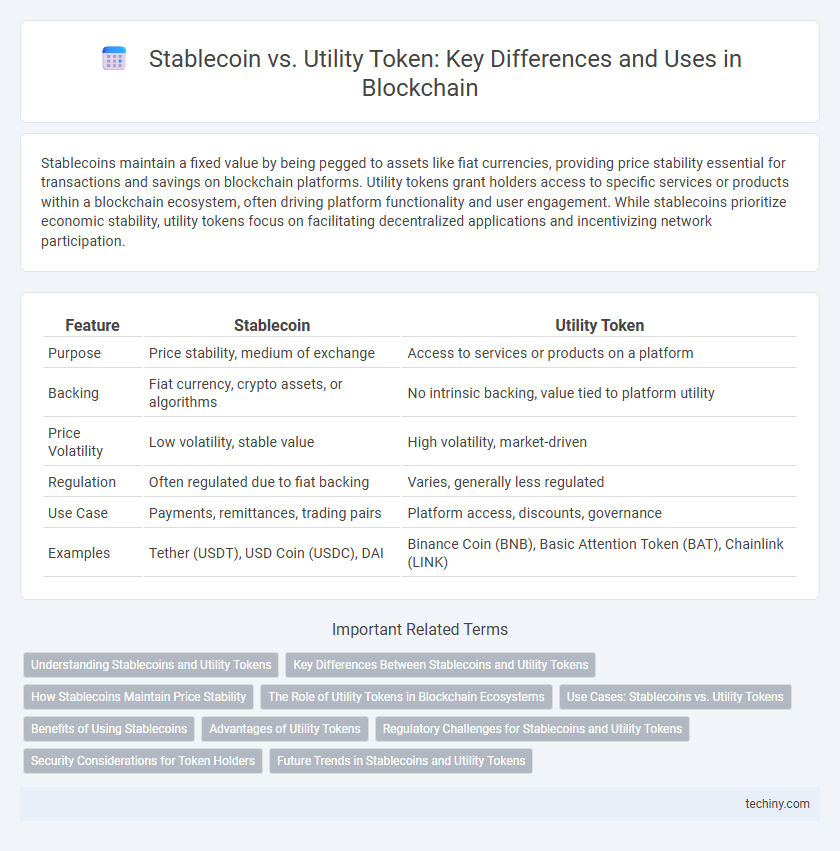Stablecoins maintain a fixed value by being pegged to assets like fiat currencies, providing price stability essential for transactions and savings on blockchain platforms. Utility tokens grant holders access to specific services or products within a blockchain ecosystem, often driving platform functionality and user engagement. While stablecoins prioritize economic stability, utility tokens focus on facilitating decentralized applications and incentivizing network participation.
Table of Comparison
| Feature | Stablecoin | Utility Token |
|---|---|---|
| Purpose | Price stability, medium of exchange | Access to services or products on a platform |
| Backing | Fiat currency, crypto assets, or algorithms | No intrinsic backing, value tied to platform utility |
| Price Volatility | Low volatility, stable value | High volatility, market-driven |
| Regulation | Often regulated due to fiat backing | Varies, generally less regulated |
| Use Case | Payments, remittances, trading pairs | Platform access, discounts, governance |
| Examples | Tether (USDT), USD Coin (USDC), DAI | Binance Coin (BNB), Basic Attention Token (BAT), Chainlink (LINK) |
Understanding Stablecoins and Utility Tokens
Stablecoins maintain a consistent value by being pegged to assets like fiat currencies, enhancing their use as a reliable medium of exchange within blockchain ecosystems. Utility tokens grant holders access to specific services or products on a platform, driving user interaction and network functionality. Distinguishing stablecoins from utility tokens is essential for grasping their roles in decentralized finance and blockchain applications.
Key Differences Between Stablecoins and Utility Tokens
Stablecoins are digital currencies designed to maintain a stable value by being pegged to assets like the US dollar or gold, making them ideal for transactions and store of value. Utility tokens provide users with access to a platform's services or products, primarily driving network functionality within decentralized applications. The key differences lie in stablecoins' price stability and use as a medium of exchange versus utility tokens' role in enabling or incentivizing platform-specific activities.
How Stablecoins Maintain Price Stability
Stablecoins maintain price stability by being pegged to reserve assets like fiat currencies or commodities, ensuring a 1:1 value ratio. They use mechanisms such as collateralization, algorithmic adjustments, or a combination of both to manage supply and demand, preventing significant price fluctuations. This stability differentiates stablecoins from utility tokens, which typically lack intrinsic value backing and are driven by project-specific use cases and market speculation.
The Role of Utility Tokens in Blockchain Ecosystems
Utility tokens serve as essential instruments within blockchain ecosystems, enabling access to specific services and functionalities on decentralized platforms. Unlike stablecoins, which primarily function as digital currencies pegged to stable assets, utility tokens facilitate governance, incentivize user participation, and support transaction validation processes. Their role drives network activity and fosters decentralized application development by embedding economic incentives aligned with platform growth.
Use Cases: Stablecoins vs. Utility Tokens
Stablecoins provide price stability by pegging their value to assets like fiat currencies, making them ideal for everyday transactions, remittances, and as a hedge against market volatility. Utility tokens grant access to a blockchain platform's services or products, enabling functionalities such as voting rights, decentralized app usage, and incentivized participation within ecosystems. Use cases diverge as stablecoins facilitate seamless value transfer and store of value, while utility tokens drive user engagement and governance in decentralized applications.
Benefits of Using Stablecoins
Stablecoins provide price stability by being pegged to real-world assets like fiat currencies, reducing volatility typically seen in other cryptocurrencies. Their predictable value enhances usability for everyday transactions, making them ideal for remittances, payments, and as a store of value within decentralized finance (DeFi) ecosystems. Stablecoins support seamless cross-border transfers with lower fees and faster settlement times compared to traditional banking systems.
Advantages of Utility Tokens
Utility tokens offer significant advantages by providing direct access to a blockchain platform's services, facilitating transactional efficiency without requiring external currency exchange. They often enable participation in decentralized governance, giving holders a voice in protocol upgrades and decision-making processes. Their programmability allows seamless integration with smart contracts, enhancing automation and expanding use cases within decentralized applications.
Regulatory Challenges for Stablecoins and Utility Tokens
Regulatory challenges for stablecoins often revolve around their pegging to fiat currencies, raising concerns about reserve transparency, monetary policy impact, and Anti-Money Laundering (AML) compliance. Utility tokens face regulatory scrutiny related to securities laws, specifically whether they qualify as investment contracts under frameworks like the Howey Test, affecting their issuance and trading. Both token types must navigate evolving global regulatory landscapes, including rules from authorities such as the U.S. SEC, EU MiCA regulations, and FATF guidelines, influencing market adoption and operational compliance.
Security Considerations for Token Holders
Stablecoins typically offer enhanced security through transparency and regulatory compliance, reducing volatility risks for token holders. Utility tokens may face higher security risks due to fluctuating market values and less regulatory oversight, exposing holders to potential losses. Secure smart contract implementation and thorough audit processes are crucial to protect both stablecoin and utility token investors.
Future Trends in Stablecoins and Utility Tokens
Stablecoins are increasingly poised to integrate with central bank digital currencies (CBDCs) and DeFi platforms, enhancing liquidity and promoting mainstream adoption by offering price stability and regulatory compliance. Utility tokens are expected to evolve with expanded use cases in decentralized applications (dApps), enabling more complex governance, access rights, and incentivization mechanisms within blockchain ecosystems. Future trends indicate a growing convergence where stablecoins provide seamless transactional mediums, while utility tokens drive ecosystem engagement and innovation.
Stablecoin vs Utility token Infographic

 techiny.com
techiny.com